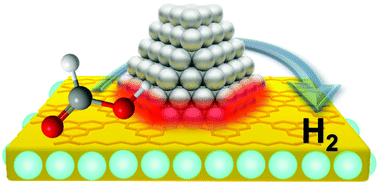Activating Pd nanoparticles on sol–gel prepared porous g-C3N4/SiO2via enlarging the Schottky barrier for efficient dehydrogenation of formic acid†
Abstract
A highly active heterogeneous catalyst, Pd nanoparticles@g-C3N4/SiO2 with tunable band structure, was successfully fabricated by a sol–gel method. The nanocomposite catalyst exhibits an extraordinary hydrogen production rate from formic acid which leads to a high turnover frequency (TOF) of around 306 mol H2 per mole Pd per h after 10 min. The characterization analysis shows that the bandgap of the g-C3N4/SiO2 support widens with decreasing synthesis temperature, which in turn allows tuning of the band structure by simply controlling the synthesis temperature. After Pd nanoparticles were embedded, the nanocomposite Pd@g-C3N4/SiO2 showed excellent catalytic performance in the dehydrogenation of formic acid at 303.15 K, and the lower the synthesis temperature of the catalyst, the higher its performance.
Since 2009, cooperative researches have been conducted between Prof. Chen from Shanghai Jiao Tong University (SJTU) and Prof. Antonietti and Dr Li from Max Planck Institute (MPI), who together developed sustainable methods for fabricating graphene aqueous dispersion and graphene–carbon nitride dyads. The cooperation between MPI and SJTU was further strengthened after Dr Li joined SJTU in 2013. In 2016, a Max Planck Partner Group was co-founded by MPI and SJTU based on the former cooperative achievements. The MPI-SJTU Partner Group for Sustainable Carbon Materials Chemistry strengthens the personal collaborative ties between the Partner Group Leader (Dr Li), the host of the partner group in China, represented by Prof. Chen of SJTU, and MPI, represented by Prof. Antonietti of MPI for Colloids and Interfaces. They also intend to foster interest-oriented research collaborations, safeguarding the continuity of scientific collaboration and research activities for their mutual benefit and progress.

- This article is part of the themed collections: HOT articles in Inorganic Chemistry Frontiers for 2016 and Sino-European Collaborators

 Please wait while we load your content...
Please wait while we load your content...